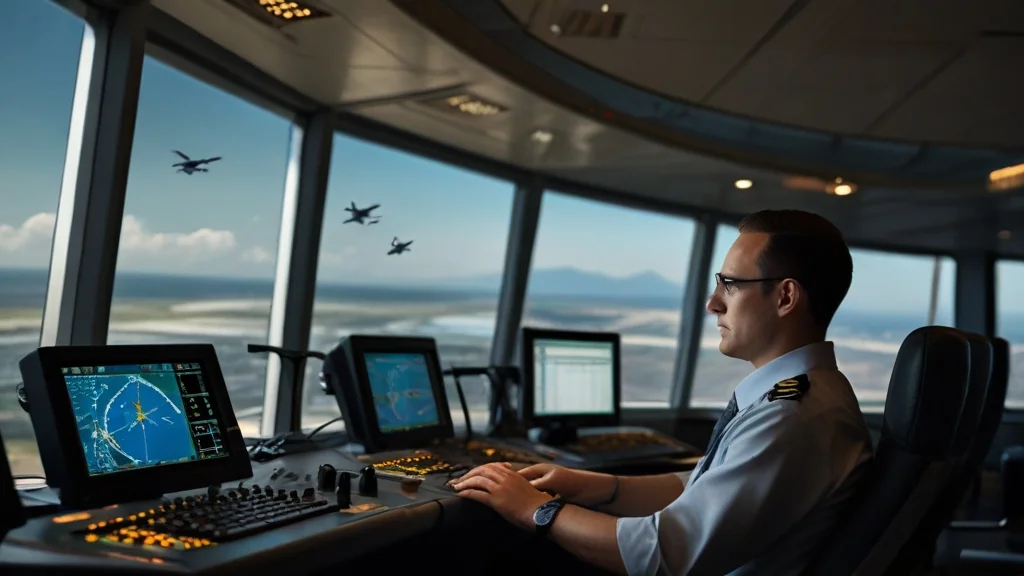A Beginner’s Guide to Understanding Air Traffic Control and Mitigating Fatigue
1. Introduction to Air Traffic Control
Air traffic control (ATC) serves as the guardian of the sky, managing the safe and orderly flow of aircraft on the ground and in the air. This section introduces the fundamentals of ATC operations and their role in aviation safety.

2. The Critical Role of Air Traffic Controllers
Here, we detail the responsibilities of air traffic controllers, from monitoring and directing the movement of aircraft to ensuring that all flight operations are conducted within the realms of safety regulations.
3. Understanding the JetBlue and Southwest Near-Miss
A closer look at the near-collision incident between JetBlue and Southwest planes, analyzing what went wrong and the potential consequences that were narrowly avoided.
4. The Human Factor: Air Traffic Control Fatigue
This section explores how fatigue among air traffic controllers can lead to lapses in concentration and judgment, increasing the risk of near-misses or collisions.
5. Causes of Air Traffic Controller Fatigue
Investigate the factors contributing to controller fatigue, from long shifts and overnight duties to the psychological stress associated with the job.
6. The Impact of Fatigue on Flight Safety
An analysis of how fatigue can impair an air traffic controller’s abilities, affecting their decision-making process and reaction times, which are crucial for maintaining flight safety.
7. Real-life Consequences of ATC Fatigue
Examining past incidents where ATC fatigue played a significant role, highlighting the real dangers and emphasizing the need for effective fatigue management strategies.
8. Strategies to Combat Air Traffic Controller Fatigue
A look at various measures and best practices that can be implemented to reduce fatigue among air traffic controllers, from scheduling improvements to fatigue risk management systems.
9. The Role of Technology in Supporting Air Traffic Controllers
Exploring technological innovations designed to assist air traffic controllers, from automated systems to AI-driven tools, and how they can help mitigate human error.
10. Regulatory Frameworks Governing Air Traffic Control Safety
Overview of the international and national regulations that oversee air traffic control operations and the standards set to ensure controller health and safety.
11. Training and Awareness Programs for Controllers
The importance of ongoing training programs aimed at enhancing awareness about fatigue and other operational risks among air traffic controllers.
12. The Future of Air Traffic Control
Speculating on the future developments in air traffic control, including advances in technology and shifts in regulatory approaches to improve ATC safety and efficiency.
13. Importance of Public Awareness
Discussing the need for increased public understanding and support for initiatives aimed at bolstering air traffic control safety.
14. How Passengers Can Contribute to Flight Safety
Tips and advice for passengers on how their actions and attitudes can contribute to overall flight safety, emphasizing the cooperative aspect of air travel.
15. Conclusion: A Unified Approach Towards Safer Skies
Summarizing the critical points covered in this guide and calling for a unified approach among regulators, airlines, air traffic controllers, and the public to enhance the safety and reliability of air travel.
—
FAQs
Qno.1: What exactly do air traffic controllers do?
A: Air traffic controllers coordinate the movement of aircraft to maintain safe distances between them on the ground and in the air, guide pilots during takeoff and landing, and monitor aircraft as they travel through the skies.
Qno.2: How can air traffic control fatigue be mitigated?
A: Measures include implementing better scheduling practices to avoid long shifts, introducing fatigue risk management systems, integrating more automation to assist controllers, and raising awareness about the importance of adequate rest and stress management.
Qno.3: What technologies are improving air traffic control?
A: Advancements such as Automated Dependent Surveillance-Broadcast (ADS-B), AI-driven prediction tools, and real-time data analytics are helping improve the efficiency and safety of air traffic control operations.
Qno.4: Why is air traffic control so stressful?
A: The job involves constant vigilance, high-stakes decisions, and the need to manage multiple aircraft simultaneously, all of which can contribute to psychological stress and physical fatigue.
Qno.5: Can the public help improve air traffic control safety?
A: While direct influence might be limited, public support for regulatory changes, funding for ATC advancements, and a better understanding of the essential work controllers do can help drive improvements in system safety and efficiency.






